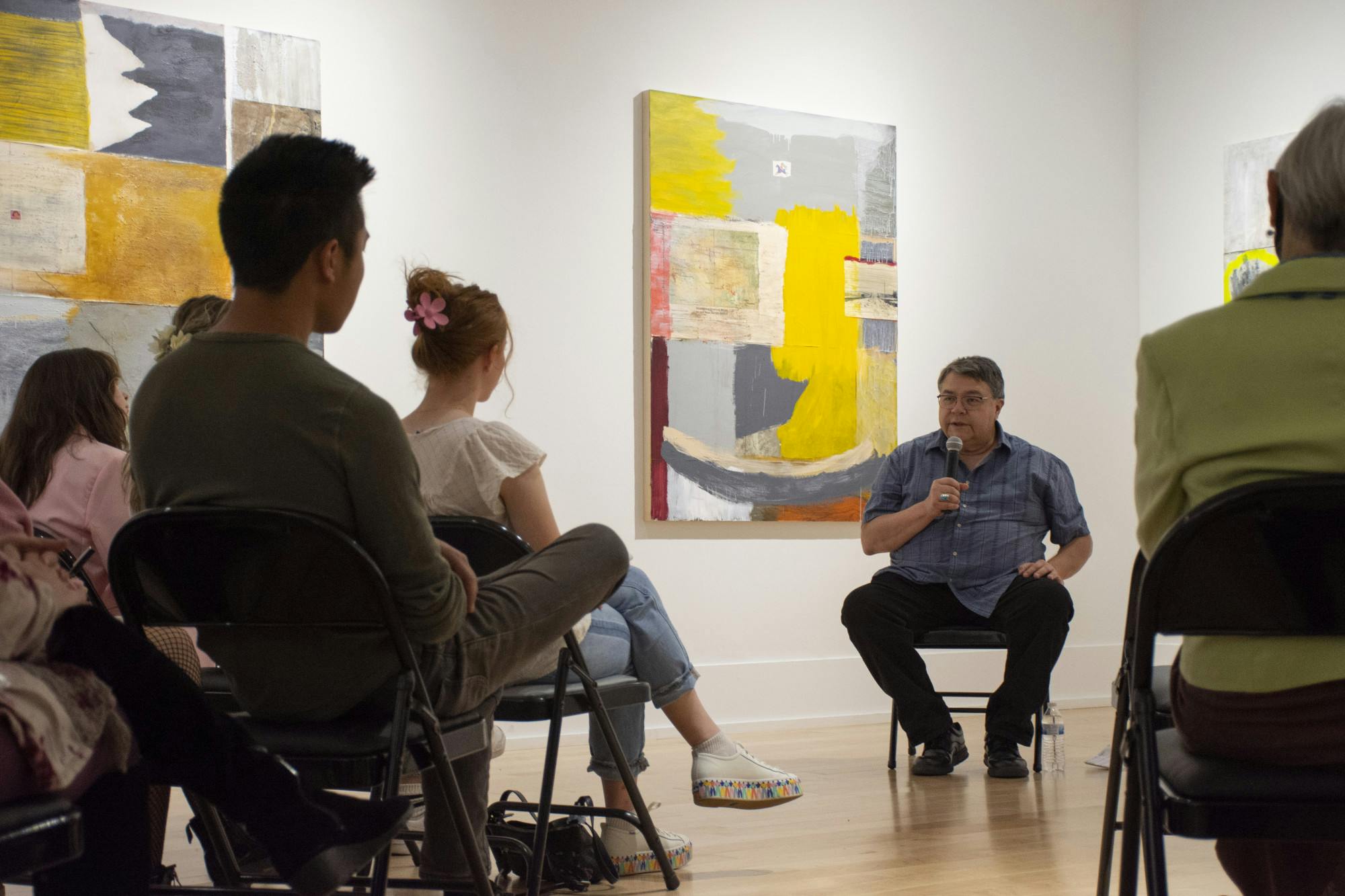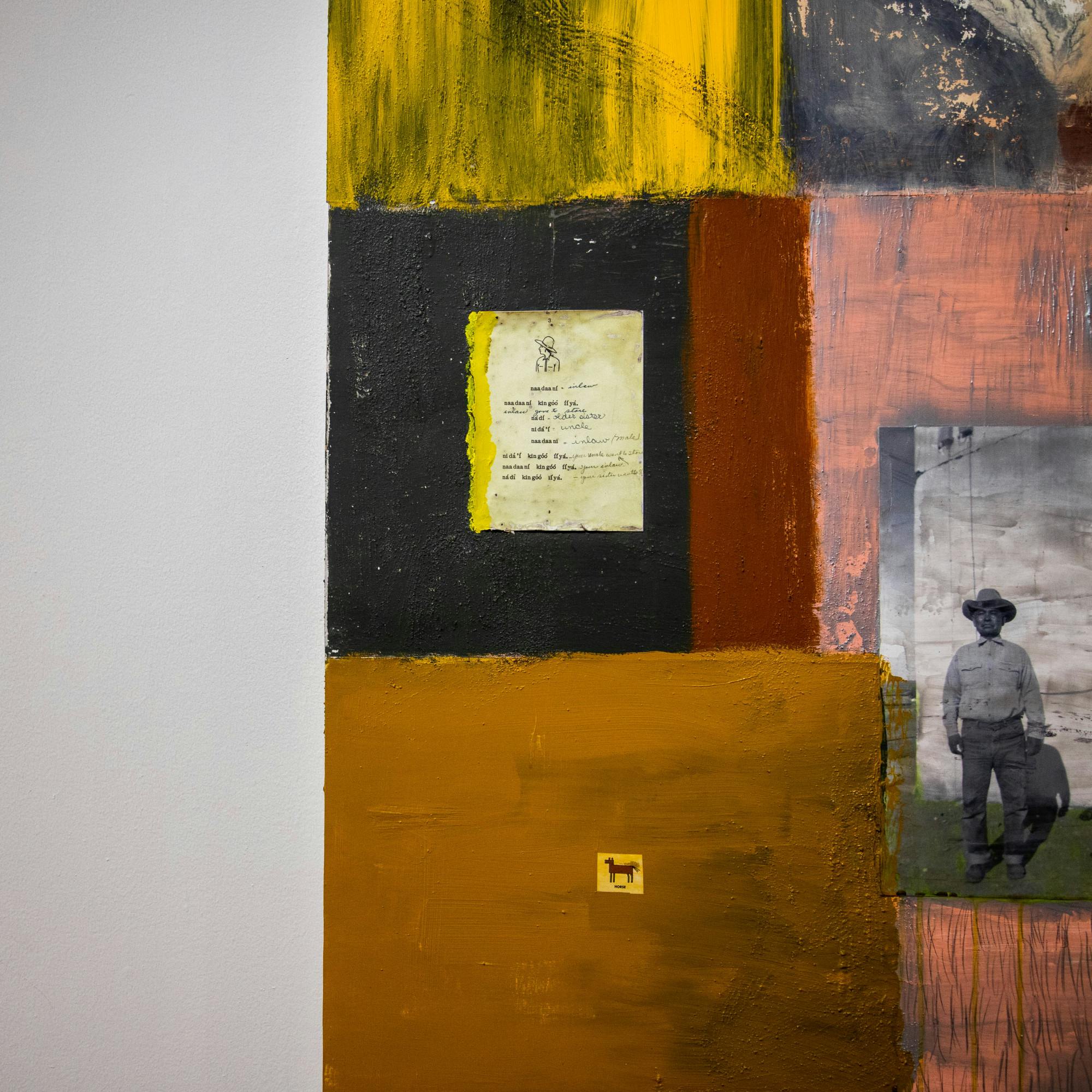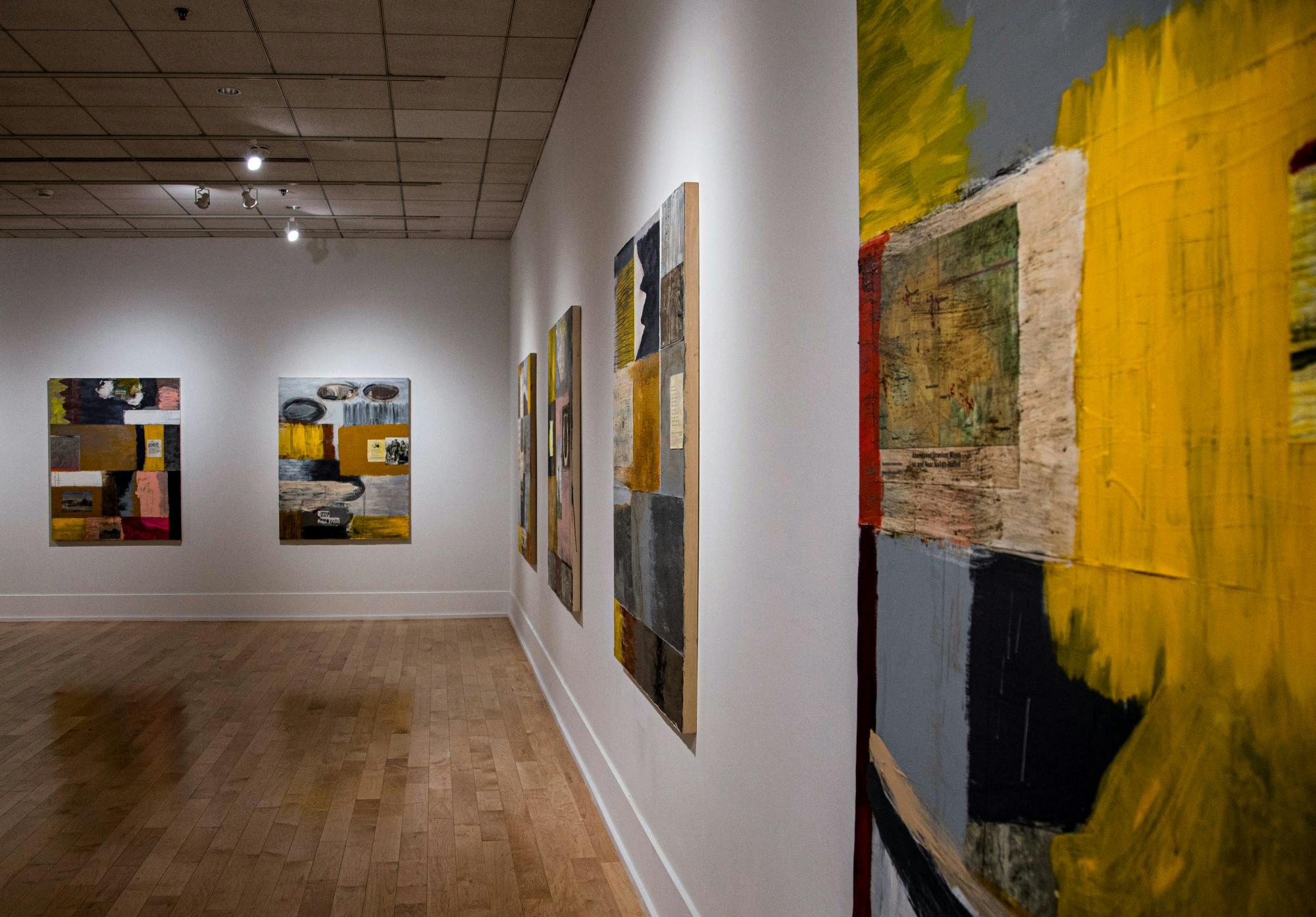The museum’s home, The Ridges, formerly known as the Athens Lunatic Asylum, represents a history of mistreatment and abuse, and some of its present-day art reveals a similar theme.
The uranium mining crisis on Navajo Nation
On Navajo land in present-day northeastern Arizona, northwestern New Mexico and southeastern Utah, 30 million tons of uranium ore was extracted between 1944 and 1986, according to the U.S. Environmental Protection Agency, or EPA. Today, there are more than 500 abandoned uranium mines on Navajo Nation.
Its radioactive properties were discovered in 1866 and became recognized as a potential energy source in the mid 20th century. Now, uranium is used “to power commercial nuclear reactors that produce electricity” and produce isotopes for medicine and defense industries.
A uranium boom in the U.S. occurred in the 1950s after World War II, according to the Utah Division of State History. The U.S. Atomic Energy Commission, or AEC, sponsored the search for uranium in the “four corners” of the Colorado Plateau, which mostly belongs to Navajo Nation.
People rushed to the area to profit off of the uranium mining and the Department of Defense sought to use uranium to build nuclear weapons. Leases were created with Navajo Nation, the EPA said, and the AEC guaranteed a purchase of all uranium mined, according to the National Library of Medicine, or NIH.
The Manhattan Project, created by the U.S. during World War II to produce the first nuclear weapons, also created an initiative to mine uranium domestically for fast purchase, according to the Atomic Heritage Foundation.
When the Cold War ended, a statement of Navajo Nation to Congress said the federal government didn’t need uranium for nuclear weapon production and mining sites on the land were abandoned.
Too much damage was done. The Church Rock uranium spill of 1979 “was the largest release of radioactive materials” on U.S. soil, the Atomic Heritage Foundation said. A crack in a wall that prevented radioactive waste from rushing into the Puerco River led to 1,100 tons of solid radioactive waste and 93 million gallons of liquid contaminating the river.
John Feodorov, a Seattle-based contemporary artist, was contacted by the Kennedy Art Museum to create an exhibit. At the time, Feodorov was furthering his knowledge about the health and environmental crisis of the abandoned uranium mines.
The health impacts of uranium mining were documented before the U.S. government even began mining. In Germany and Czechoslovakia, uranium ore was mined for centuries and a lung disease associated with mining activities was found to cause the death of nearly 75% of miners, according to the NIH.
A study conducted in 1950 by the U.S. Public Health Service, or PHS, led experts to believe that a radioactive chemical element in the mines caused lung cancer in uranium miners in the Colorado Plateau.
While the study initially focused on white miners, a full analysis on the Navajo population was conducted in 1984.
Navajo mines were also paid minimum wage or less. The NIH said a copy of a pay stub shows one miner was paid between $0.81 to $1.00 an hour.
The Science History Institute said that around 85% of original radioactivity remains from unmarked piles of debris and rocks from the mines, affecting most people living on Navajo Nation.
The Southwest Research and Information Center has researched the effects of the uranium mines on Navajo health since 1952. The center finds, using research from the University of New Mexico and the Miners Colfax Hospital in New Mexico, that 68% of miners who worked prior to 1971 and 66% of miners who worked after 1971 “had abnormal chest X-rays indicative of pneumoconiosis –” a lung disease listed under the Radiation Compensation Exposure Act, or RECA.
In 1990, RECA listed lung cancer, breast cancer, fibrosis of the lung, silicosis and others as “compensable diseases” for uranium miners and others working for mining companies. However, miners who worked after Dec. 31, 1971 aren’t eligible for compensation, according to the Southwest Research and Information Center.
The EPA has a 10-year plan to clean up the abandoned mines and address other impacts of uranium contamination on the Navajo Nation. The plan aims to clean up 230 mining sites at contaminated structures, but the exposure to uranium has already left consequences.
The museum’s connection to the mines and Navajo art
The Kennedy Art Museum is named after Edwin L. Kennedy, a former OU Foundation Trustee and donor, and his wife Ruth E. Kennedy. The two were OU alumni who donated their collection of Southwest Native American art to the museum.
“Someone mentioned that the namesake for the Kennedy Museum, Edwin Kennedy, actually was on the Navajo reservation working for a uranium mining company (and) looking for places to mine,” Feodorov said.
An American energy company, the Kerr-McGee Corporation, elected Kennedy to the oil exploration company’s board of directors in 1949. In 1952, the Kerr-McGee Corporation obtained a uranium mining company in northeastern Arizona on Navajo land. Two years later, the company built a uranium processing plant.
“As a director and financial adviser for the company, Kennedy accompanied a regional manager of Kerr-McGee on an automobile trip in 1954 to the Lukachukai Mountains, where they were scheduled to inspect the mine and the new mill,” Keller said.
The two made a stop at a building with the sign “Red Rock Trading Post” with the names “Kennedy and McGee” labeled underneath, Keller said. Inside, they met one of the co-owners of the trading post, who did not have a family connection to the late name.
Kennedy was shown a display of Navajo blankets and regarded it with beauty.
“Despite an admitted lack of knowledge about the tribe or its weavings, Edwin Kennedy purchased a white Yei blanket woven by Vera Begay, the wife of a medicine man,” Keller said.
“This began Kennedy’s “unexpected intimacy with the Navajo culture,” Keller said, and an interest in collecting Navajo art through the Red Rock Trading Post.
The “Night Skies: Navajo Textiles Depicting Sandpaintings” exhibit includes textiles from the Kennedy’s collection. Edwin Kennedy commissioned Red Rock area weavers to create these weavings in the 1960s and the collection is made up of almost 700 textiles.
Sally Delgado, the Kennedy Art Museum’s curator of education, said only 12 of the weavings are hung up in the exhibit. The rest are kept in temperature controlled storage to be kept safe from damage.
Navajo sandpaintings, according to the Natural History Museum of Utah, are ceremonious and “include sets of actions and elements performed in sequence, often over many days, to bring about healing and the return of balance and harmony to individuals and the universe.”
The medicine person is responsible for creating the sandpaintings, which is sometimes called dry painting, “on the floor of the ceremonial hogan.” The hogan is a traditional Navajo dwelling and ceremonial structure. Colored sand is trickled onto the surface and the medicine person “illustrates sacred places, stories and beings from Diné belief and culture.”
Despah Nez, a Red Rock area weaver, and her two daughters, Anna Mae Tanner and Alberta Thomas made most of the weavings presented in the exhibit. Gladys Manuelito and Mary Ann Foster also contributed weavings to the collection.
Controversy surrounds the commissioned Navajo weavings because the practice isn’t meant to be permanent.
“The ceremony is performed, and then all of that goes back out into nature,” Delgado said. “So it’s very temporary.”
How ‘Yellow Dirt’ and Feodorov came to be
“Yellow Dirt” is the exhibit of 12 paintings created by Feodorov that hang in the room across from “Night Skies.” The exhibit was, for one reason, necessary to make because of Kennedy’s connection to the uranium mines and Navajo sandpaintings, Feodorov said.

(Provided and taken by Madeline Melragon, student curator and commercial photography major at OHIO
John Feodorv, the artist behind “Yellow Dirt”, speaks at an event about the paintings at the Kennedy Art Museum.
“And for me that just seemed like a bolt of lightning,” Feodorov said. “This has to be done. This exhibition has to happen and it needs to be specific.”
Shades of yellow, pink, brown and gray painted in various rectangular shapes and rigid and smooth textures on the 12 wooden panels resemble the environmental and health crisis caused by the abandoned uranium mines on and near the Navajo reservation in the collection.
When Feodorov studied drawing and painting at California State University, Long Beach, he became frustrated with art being used as a commodity to sell to rich people. Feodorov dropped out of college for a while but returned once he realized he could make art to respond to personal experiences and figuring out how the world works.
“We think of everything in our culture as valuable if it amounts to a career,” Feodorov said. “I’ve been painting and making art all my life without ever getting paid for it. I’m not making it to sell or to make money. I’m making it because I need to make it.”
While growing up in Southern California, Feodorov remembered loving music and art but he was different from his peers. In school, Feodorov refused to say the Pledge of Allegiance during the Cold War, and was bullied for his Navajo heritage.
“I was the half Navajo, half white kid growing up in Los Angeles,” Feodorov said. “But we would go back and forth between the reservations so that was a completely different experience.”
Sometimes art and forms of entertainment are used as distractions for people, but Feodorov said he cannot imagine not having art as a way to address his experiences and work through problems and complexities.
“I think for me, art was a way, at first, to try to resolve those (contradictions),” Feodorov said. “But I later figured out that they’re not resolvable. And so it’s really been a matter of … putting it out there (through art) and thinking about it differently instead of just internalizing it.”
The exhibit’s curation process
Students at OU who work at the museum and carefully transported Feodorov’s paintings from the basement to the first floor of the exhibition room.
Lily Adams, a sophomore studying studio art, said she wants to work in museums full-time in the future and play an “empathetic” and “genuine” role in curating art.
When Adams was taking a break from the first day of curating the Yellow Dirt exhibition, she said the experience handling the paintings was special because Feodorov sent the original Yellow Dirt artwork to the museum.
“It’s been really nice to see John Feodorov’s creative process,” Adams said. “It’s really cool because being an artist you know how much work you put into that. He signed all the backbone and labeled all of them.”
Yellow Dirt’s transportation was a delicate process. Ashley Kouri, a second year graduate student studying integrated media, is the graduate assistant curator at the museum. Kouri said the student curators ensure the artist’s creation is safe.
“There’s a lot of emotional pressure. We’re trusted with this; the heart and soul of the artist. So we’re extra extra careful. But we’re close to the painting and handling it. It’s scary sometimes just because you’re so trusted with this.”-Ashley Kouri, graduate assistant curator at the Kennedy Art Museum
The students also carry the paintings’ message with them. Madeline Melragon, a junior studying commercial photography, takes photos of the work at the museum and the exhibits.
“We have so much Native American artwork,” Melragon said. “But we don’t have anything directly commissioned by Native American artists. This project is really cool because of that.”
The difference between the Night Skies exhibit and the Yellow Dirt exhibit are transparent. Night Skies is an exhibit of Navajo sandpaintings depicted as weavings commissioned by Kennedy, and Yellow Dirt is a collection of paintings by Feodorov emphasizing the uranium crisis on Navajo reservation caused by injustice.
“So I think it’s really important that when you’re curating work, you’re also curating how it’s being visualized and responded to,” Kouri said. “A lot of museums don’t tell you those stories. They don’t tell you where it came from. The Feodorov exhibition is really genuine … It’s not taking it from somewhere else.”
Feodorov was impressed by the Kennedy Art Museum’s “awareness and sensitivity” about the Night Skies exhibit. He said that museums, generally, are becoming less defensive about the history of stolen artifacts and other problematic ways similar institutions received their artwork.
The impact of Feodorov’s paintings

Carrie Legg | Photo Editor
Various printed aspects are incorporated into the paintings by John Feodorov as part of his Yellow Dirt exhibit featured at the Kennedy Museum of Art.
For “Yellow Dirt,'' Feodorov printed photos of areas where his family lived on Navajo reservation and glued them to the wooden panels to guide him through the process of then painting.
“I had something to respond to,” Feodorov said. “I tried to just respond knowing that this was my family’s land, the history of my family, but also the topographic shapes of the maps. Sometimes you could see the mines and the tailing ponds where they evaporate the contaminated water.”
Feodorov’s exhibit shares with its viewers how art can personally connect the injustices of the past to their consequences in the present.
Yellow Dirt, through its colors representing uranium contamination and its shapes revealing stolen land, reminds people that the treatment of Navajo Nation by the government holds a place for reflection. Feodorov used his own family’s photos for personal reflection of the uranium mining crisis to not speak for all members of Navajo Nation.
The exhibit is open from now until Dec. 18 at the Kennedy Art Museum located at 100 Ridges Cir. Admission to the museum is free and is open from 10 a.m. to 5 p.m. from Monday to Friday and 1 p.m. to 5 p.m. on Saturday and Sunday.
“I can’t imagine not having art as a way to address these things,” Feodorov said. “There are so many people that don’t have art and I can’t imagine not being able to do that … For me art is that way of not trying to distract myself from what I’m thinking and experiencing but trying to figure s—- out.”
Correction appended: A previous version of this article stated the name Abby Querry, when it’s actually Ashley Kouri. This article has been updated to reflect the most accurate information.

